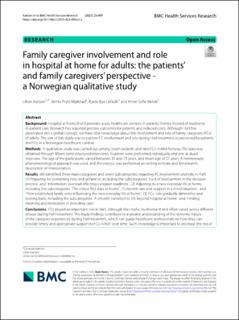| dc.description.abstract | Background
Hospital at home (HaH) provides acute healthcare services in patients’ homes instead of traditional in-patient care. Research has reported positive outcomes for patients and reduced costs. Although HaH has developed into a global concept, we have little knowledge about the involvement and role of family caregivers (FCs) of adults. The aim of this study was to explore FC involvement and role during HaH treatment as perceived by patients and FCs in a Norwegian healthcare context.
Methods
A qualitative study was carried out among seven patients and nine FCs in Mid-Norway. The data was obtained through fifteen semi-structured interviews; fourteen were performed individually and one as duad interview. The age of the participants varied between 31 and 73 years, and mean age of 57 years. A hermeneutic phenomenological approach was used, and the analysis was performed according to Kvale and Brinkmann’s description of interpretation.
Results
We identified three main categories and seven subcategories regarding FC involvement and role in HaH: (1) Preparing for something new and unfamiliar, including the subcategories ‘Lack of involvement in the decision process‘ and ‘Information overload affecting caregiver readiness‘, (2) Adjusting to a new everyday life at home, including the subcategories ‘The critical first days at home‘, ‘Coherent care and support in a novel situation‘, and ‘Prior established family roles influencing the new everyday life at home‘, (3) FCs‘ role gradually diminishes and looking back, including the subcategories ‘A smooth transition to life beyond hospital at home‘ and ‘Finding meaning and motivation in providing care‘.
Conclusions
FCs played an important role in HaH, although their tasks, involvement and effort varied across different phases during HaH treatment. The study findings contribute to a greater understanding of the dynamic nature of the caregiver experiences during HaH treatment, which can guide healthcare professionals on how they can provide timely and appropriate support to FCs in HaH over time. Such knowledge is important to decrease the risk of caregiver distress during HaH treatment. Further work, such as longitudinal studies, should be done to examine the course of caregiving in HaH over time to correct or support the phases described in this study. | en_US |

